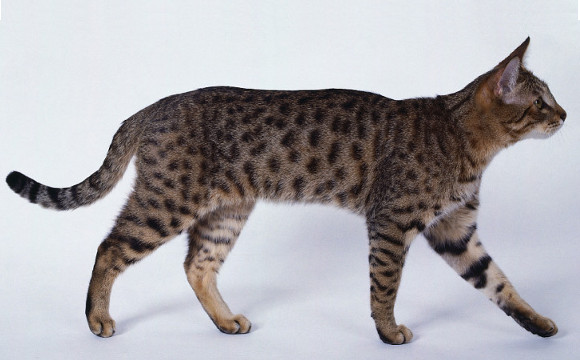History
exactly when and where the Japanese Bobtail developed is not known. It’s clear, however, that the breed has been bobbing around the Far East for at least several centuries, and perhaps much longer, since early Japanese folklore contains numerous references to short-tailed cats. One well-known tale tells of a small, short-tailed female cat named Maneki-Neko that was said to have beckoned to passersby and that was associated with good fortune. A representation of Maneki-Neko, with one paw raised in welcome, appears on the facade of the Gotokuji Temple near Tokyo.
While historical records do not explain the origin of the Japanese Bobtail, Japanese folklore does. A well-known legend tells of a sleeping cat whose tail caught on fire from a spark from the nearby hearth. The frightened cat ran through the streets of the Imperial City, lighting all the houses on fire. By morning, the city was destroyed and the Emperor, angry at the destruction of the city, decreed that all cats must have their tails cut short to prevent another such disaster from occurring.
Domestic cats were introduced into Japan from China and Korea in the early sixth century, but whether these cats had bobbed tails is unclear. The bobbed tail was definitely common by the early seventeenth century, since tricolored cats with pom-pom tails have been portrayed in numerous Japanese woodcut prints and painted silkscreen paintings of that period. Tricolored cats, mostly white with patches of red and black, are called Mi-Ke (pronounced mee-kay). Bobtails of this pattern are considered good luck. The Japanese revered these cats for their grace and beauty, and the cats were prized and kept in the temples and homes of the Imperial Japanese families for many years.
At some point between the thirteenth and fifteenth centuries, when the Japanese silk industry grew in importance and when mice threatened to destroy the silkworms and their cocoons from which the precious silk was harvested, the government decided that cats should be set free to protect the silk industry and the grain stores. The Japanese Bobtail then became a street cat instead of a pampered household pet.
In the United States, you are likely to see Bobtails only in cat shows and in the homes of breeders and fanciers, but in Japan today this breed can be seen in the streets and alleys, as well as in the average cat-loving home. Until recently in its native land, the Japanese Bobtail was considered a common domestic rather than a purebred, just as our own American Shorthair was considered a domestic for many years. It was only in the 1960s when the United States began including the breed in its cat shows that Japan followed suit; however, the Bobtail is still thought to represent good luck, and figurines of Maneki-Neko can be purchased in many Japanese stores.
The first documented Japanese Bobtails were imported into the United States from Japan in 1908. American servicemen brought home Bobtails from Japan, but it wasn’t until breeder Elizabeth Freret imported three Japanese Bobtails into the United States from Japan in 1968 that a formal American breeding and exhibiting program began.
Freret acquired the three Japanese Bobtails from a breeder who had been breeding Bobtails in Japan since shortly after WWII. Freret, along with others interested in the breed, worked to establish a standard and presented the breed to the CFA board. In 1969 the CFA accepted Japanese Bobtails for registration. In 1971 Bobs were granted provisional status, and in 1976 gained Championship status in the CFA. Today, all the major cat associations accept the Japanese Bobtail for Championship.
Recently, a longhaired version of the breed has been accepted and is recognized by CFA, TICA, ACA, AACE, UFO, CCA, and ACFA. The numbers of registrations in this newly accepted division are currently small. Evidence suggests that longhaired Bobtails have been around for as long as the shorthaired version. While longhaired cats were not as common, they appear in early Japanese artwork as well. In the cold provinces of Japan’s northernmost islands, where a long coat would be a vital survival trait, longhaired cats have been observed in the street cat populations for years.
Since the Japanese Bobtail was a common street cat for so long, it is likely that somewhere along the bloodline they acquired the recessive gene for long hair. Since two copies of a recessive gene are required for the trait to be expressed, the longhair gene can be passed through many generations before manifesting. Even when both parents possess the gene, the ratio of shorthaired over longhaired offspring is approximately 3 to 1.
Bobs make outstanding companions. They’re curious, bold, intelligent, and alert, and easily adjust to new people, situations, and animals, making them easy cats to show. Bobtails are active, but not annoyingly so. Their play is interactive and endearing. They want to be involved with their human companions and are more than willing to lend a paw when you need it (and even when you don’t). Bobtails also enjoy a good conversation; they have chirping voices that produce a wide range of tones some breeders describe this as “singing”.
The gene responsible for the pom-pom tail is a simple recessive; Bobtail to Bobtail crosses produce 100 percent Bobtail offspring. The Japanese Bobtail gene is not related to the Manx gene and doesn’t appear to be associated with any genetic defects. The tail’s fur camouflages the underlying bone structure, which varies greatly from cat to cat. The tail is usually about 4 inches (10 cm) long, but curls into a corkscrew shape so it appears much shorter.
- ☆☆☆☆☆☆☆☆ Activity
- ☆☆☆☆☆☆☆☆☆ Playfulness
- ☆☆☆☆☆☆☆☆ Need for Attention
- ☆☆☆☆☆☆☆☆☆ Affection
- ☆☆☆☆☆☆☆☆ Need to Vocalize
- ☆☆☆☆ Docility
- ☆☆☆☆☆☆☆☆ Intelligence
- ☆☆☆☆ Independence
- ☆☆☆☆☆ Healthiness and Hardiness
- ☆☆☆☆ Grooming needs
- ☆☆☆☆☆☆☆ Good with children
- ☆☆☆☆☆☆☆ Good with other pets













